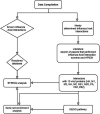A Review and Meta-Analysis of Influenza Interactome Studies
- PMID: 35531276
- PMCID: PMC9069142
- DOI: 10.3389/fmicb.2022.869406
A Review and Meta-Analysis of Influenza Interactome Studies
Abstract
Annually, the influenza virus causes 500,000 deaths worldwide. Influenza-associated mortality and morbidity is especially high among the elderly, children, and patients with chronic diseases. While there are antivirals available against influenza, such as neuraminidase inhibitors and adamantanes, there is growing resistance against these drugs. Thus, there is a need for novel antivirals for resistant influenza strains. Host-directed therapies are a potential strategy for influenza as host processes are conserved and are less prone mutations as compared to virus-directed therapies. A literature search was performed for papers that performed viral-host interaction screens and the Reactome pathway database was used for the bioinformatics analysis. A total of 15 studies were curated and 1717 common interactors were uncovered among all these studies. KEGG analysis, Enrichr analysis, STRING interaction analysis was performed on these interactors. Therefore, we have identified novel host pathways that can be targeted for host-directed therapy against influenza in our review.
Keywords: bioinformatics; host-pathogen interactions; influenza; influenza proteins; interactome analysis.
Copyright © 2022 Chua, Cui, Engelberg and Lim.
Conflict of interest statement
The authors declare that the research was conducted in the absence of any commercial or financial relationships that could be construed as a potential conflict of interest.
Figures



Similar articles
-
Prophylaxis and treatment of influenza virus infection.BioDrugs. 2001;15(5):303-23. doi: 10.2165/00063030-200115050-00003. BioDrugs. 2001. PMID: 11437694 Review.
-
Host-targeted nitazoxanide has a high barrier to resistance but does not reduce the emergence or proliferation of oseltamivir-resistant influenza viruses in vitro or in vivo when used in combination with oseltamivir.Antiviral Res. 2020 Aug;180:104851. doi: 10.1016/j.antiviral.2020.104851. Epub 2020 Jun 13. Antiviral Res. 2020. PMID: 32544408
-
RNAi-based small molecule repositioning reveals clinically approved urea-based kinase inhibitors as broadly active antivirals.PLoS Pathog. 2019 Mar 18;15(3):e1007601. doi: 10.1371/journal.ppat.1007601. eCollection 2019 Mar. PLoS Pathog. 2019. PMID: 30883607 Free PMC article.
-
Viral RNA polymerase: a promising antiviral target for influenza A virus.Curr Med Chem. 2013;20(31):3923-34. doi: 10.2174/09298673113209990208. Curr Med Chem. 2013. PMID: 23931274 Review.
-
Antivirals and resistance: influenza virus.Curr Opin Virol. 2011 Dec;1(6):563-73. doi: 10.1016/j.coviro.2011.09.002. Epub 2011 Oct 4. Curr Opin Virol. 2011. PMID: 22440914 Review.
Cited by
-
The ER-Golgi transport of influenza virus through NS1-Sec13 association during virus replication.Microbiol Spectr. 2024 Jan 11;12(1):e0260923. doi: 10.1128/spectrum.02609-23. Epub 2023 Dec 1. Microbiol Spectr. 2024. PMID: 38038453 Free PMC article.
-
Phosphatidylinositol 4,5-Bisphosphate Mediates the Co-Distribution of Influenza A Hemagglutinin and Matrix Protein M1 at the Plasma Membrane.Viruses. 2022 Nov 12;14(11):2509. doi: 10.3390/v14112509. Viruses. 2022. PMID: 36423118 Free PMC article.
-
Virulence network of interacting domains of influenza a and mouse proteins.Front Bioinform. 2023 Feb 17;3:1123993. doi: 10.3389/fbinf.2023.1123993. eCollection 2023. Front Bioinform. 2023. PMID: 36875146 Free PMC article.
-
Identification of ULK1 as a novel mitophagy-related gene in diabetic nephropathy.Front Endocrinol (Lausanne). 2023 Jan 18;13:1079465. doi: 10.3389/fendo.2022.1079465. eCollection 2022. Front Endocrinol (Lausanne). 2023. PMID: 36743936 Free PMC article.
-
Influenza A Virus Infection Alters Lipid Packing and Surface Electrostatic Potential of the Host Plasma Membrane.Viruses. 2023 Aug 29;15(9):1830. doi: 10.3390/v15091830. Viruses. 2023. PMID: 37766238 Free PMC article.
References
Publication types
LinkOut - more resources
Full Text Sources

